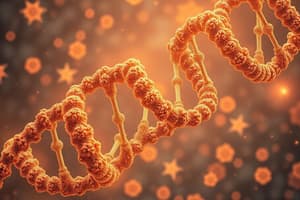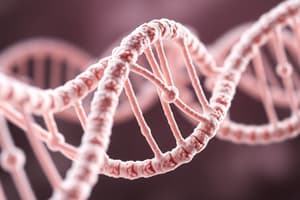Podcast
Questions and Answers
What is the composition of the DNA backbone?
What is the composition of the DNA backbone?
- Alternating sugar and phosphate groups (correct)
- Alternating sugars and nitrogenous bases
- Two intertwining strands of nitrogenous bases
- Nucleotide pairs linked by hydrogen bonds
How do the strands of DNA run in relation to each other?
How do the strands of DNA run in relation to each other?
- One strand runs 5' to 3' and the other 3' to 5' (correct)
- They are parallel to each other
- Both strands run 5' to 3'
- One strand runs 3' to 5' and the other 5' to 3'
Which nitrogenous base pairs with Adenine in DNA?
Which nitrogenous base pairs with Adenine in DNA?
- Guanine (G)
- Cytosine (C)
- Uracil (U)
- Thymine (T) (correct)
What is the total number of types of nitrogenous bases in DNA?
What is the total number of types of nitrogenous bases in DNA?
Which statement about the base pairing rules in DNA is correct?
Which statement about the base pairing rules in DNA is correct?
Flashcards are hidden until you start studying
Study Notes
DNA Structure
Double Helix Model
- Formulated by James Watson and Francis Crick in 1953.
- Structure consists of two intertwined strands forming a right-handed helix.
- The backbone is composed of alternating sugar (deoxyribose) and phosphate groups.
- The strands run in opposite directions (antiparallel) – one runs 5' to 3', the other 3' to 5'.
- The interior of the helix contains nitrogenous bases that pair specifically.
Nucleotide Composition
- DNA is made up of four nucleotides, each composed of three components:
- Phosphate group
- Deoxyribose sugar
- Nitrogenous base (one of four types)
- The four nitrogenous bases include:
- Adenine (A)
- Thymine (T)
- Cytosine (C)
- Guanine (G)
- Nucleotides link together through covalent bonds between the phosphate of one nucleotide and the sugar of another.
Base Pairing Rules
- Specific pairing between nitrogenous bases is critical for DNA structure:
- Adenine (A) pairs with Thymine (T) via two hydrogen bonds.
- Cytosine (C) pairs with Guanine (G) via three hydrogen bonds.
- This complementary base pairing is essential for DNA replication and transcription.
- The arrangement of base pairs allows for the encoding of genetic information.
DNA Structure
- The double helix structure of DNA was discovered in 1953 by James Watson and Francis Crick.
- The DNA double helix is composed of two intertwined strands arranged in a right-handed spiral.
- Each strand is made up of a backbone of alternating deoxyribose sugar and phosphate groups.
- The strands run in opposite directions, one running from 5' to 3' and the other from 3' to 5', known as antiparallel.
- The inside of the helix contains nitrogenous bases held together by hydrogen bonds.
- Each nucleotide consists of a phosphate group, a deoxyribose sugar, and a nitrogenous base.
- There are four nitrogenous bases in DNA:
- Adenine (A)
- Thymine (T)
- Cytosine (C)
- Guanine (G)
- Adenine (A) always pairs with Thymine (T), forming two hydrogen bonds.
- Cytosine (C) always pairs with Guanine (G), forming three hydrogen bonds.
- These complementary base pairs are crucial for DNA replication and transcription.
- The specific sequence of base pairs in DNA carries the genetic information.
Studying That Suits You
Use AI to generate personalized quizzes and flashcards to suit your learning preferences.




